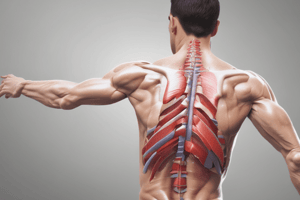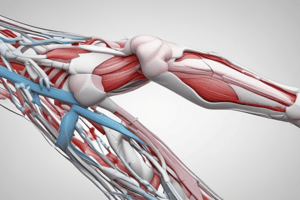Podcast
Questions and Answers
What is the purpose of Total Knee Arthroplasty?
What is the purpose of Total Knee Arthroplasty?
- To relieve knee pain and restore function (correct)
- To replace a damaged hip joint
- To improve shoulder function
- To treat elbow arthritis
What are the types of post-operative care for Total Knee Arthroplasty?
What are the types of post-operative care for Total Knee Arthroplasty?
- Early P.O, Mid-P.O, and Late P.O (correct)
- Late P.O and Early P.O
- Mid-P.O and Late P.O
- Early P.O and Mid-P.O
What is the role of physiotherapy in the rehabilitation process after Total Knee Arthroplasty?
What is the role of physiotherapy in the rehabilitation process after Total Knee Arthroplasty?
- It is only necessary for advanced exercises
- It only focuses on pain management
- It helps improve range of motion, strength, and function of the knee joint (correct)
- It has no role in the rehabilitation process
What challenges are commonly faced in physiotherapy after Total Knee Arthroplasty?
What challenges are commonly faced in physiotherapy after Total Knee Arthroplasty?
What are the benefits of physiotherapy in Total Knee Arthroplasty?
What are the benefits of physiotherapy in Total Knee Arthroplasty?
What are the expected future advancements in knee arthroplasty?
What are the expected future advancements in knee arthroplasty?
What does Total Hip Replacement aim to provide?
What does Total Hip Replacement aim to provide?
What are the non-surgical alternatives to Total Hip Replacement not able to provide?
What are the non-surgical alternatives to Total Hip Replacement not able to provide?
What can manage the risks of Total Hip Replacement procedure?
What can manage the risks of Total Hip Replacement procedure?
"What is the artificial joint used in Total Knee Arthroplasty made of?"
"What is the artificial joint used in Total Knee Arthroplasty made of?"
What is a joint dislocation?
What is a joint dislocation?
What are the common causes of joint dislocations?
What are the common causes of joint dislocations?
Which joints are frequently dislocated?
Which joints are frequently dislocated?
What is the purpose of immobilization after joint reduction?
What is the purpose of immobilization after joint reduction?
What is closed reduction in the management of joint dislocations?
What is closed reduction in the management of joint dislocations?
What is open reduction in the management of joint dislocations?
What is open reduction in the management of joint dislocations?
Which imaging techniques may be necessary to confirm a joint dislocation diagnosis?
Which imaging techniques may be necessary to confirm a joint dislocation diagnosis?
What information is important to gather during the history assessment of a joint dislocation?
What information is important to gather during the history assessment of a joint dislocation?
What should be evaluated during the physical examination of a joint dislocation?
What should be evaluated during the physical examination of a joint dislocation?
When is open reduction recommended in the management of joint dislocations?
When is open reduction recommended in the management of joint dislocations?
Which joint dislocation is the most common?
Which joint dislocation is the most common?
What technique may be required for reducing anterior hip dislocations?
What technique may be required for reducing anterior hip dislocations?
Who developed the modern design of total hip replacement in the 1940s and 1960s?
Who developed the modern design of total hip replacement in the 1940s and 1960s?
What are the potential indications for hip replacement?
What are the potential indications for hip replacement?
What are the benefits of total hip replacement?
What are the benefits of total hip replacement?
Which joint dislocation is the second most common large joint dislocation?
Which joint dislocation is the second most common large joint dislocation?
What can be prescribed for pain management in joint dislocations?
What can be prescribed for pain management in joint dislocations?
What is involved in the procedure of total hip replacement?
What is involved in the procedure of total hip replacement?
'Terrible triad' refers to potential injury to which parts in elbow dislocation?
'Terrible triad' refers to potential injury to which parts in elbow dislocation?
What is the most common position for knee dislocation?
What is the most common position for knee dislocation?
Study Notes
- Physical Therapy: Essential for restoring joint function, preventing stiffness, and strengthening muscles after joint dislocation.
- Pain Management: Analgesics and anti-inflammatory medications may be prescribed to manage pain and reduce inflammation.
- Shoulder Dislocation: Most common joint dislocation, with 90% being anterior and 4-10% being posterior. Anterior dislocations are often caused by static forces, while posterior dislocations are from dynamic forces.
- Hip Dislocation: Can be anterior or posterior with various reduction techniques. Anterior dislocations may require axial load in a flexed, adducted hip, while posterior dislocations require flexion, abduction, and external rotation.
- Knee Dislocation: Most common in the anterior position due to hyperextension force to the anterior tibia, with valgus, varus, or rotational forces also possible.
- Elbow Dislocation: Second most common large joint dislocation, can be simple or complex with potential injury to the radial head, coronoid, or all three forming the terrible triad.
- Total Hip Replacement: A surgical procedure where a damaged hip joint is replaced with an artificial joint. Developed in the 1940s and 1960s, now includes minimally invasive and robotic-assisted surgeries.
- History of Total Hip Replacement: Originated in ancient Egypt with bronze and gold fingers, modern design developed by Sir John Charnley in the 1940s and 1960s.
- Types of Hip Replacement: Total hip replacement involves removing the pelvis and head of the thighbone, partial hip replacement (hemiarthroplasty) only replaces the femoral head.
- Indications for Hip Replacement: Osteoarthritis, rheumatoid arthritis, injury/fracture, hip osteonecrosis.
- Procedure of Total Hip Replacement: Incision, joint preparation, implantation, post-operative care.
- Benefits of Total Hip Replacement: Pain relief, mobility, improved quality of life, longevity of prosthetic hip.
- Risks and Complications of Total Hip Replacement: Infection, implant loosening, wear damage, blood clots, dislocation, potential need for revision surgery.
Studying That Suits You
Use AI to generate personalized quizzes and flashcards to suit your learning preferences.
Related Documents
Description
Learn about the definition, causes, and clinical assessment of joint dislocations, including commonly dislocated joints such as the shoulder, elbow, finger, hip, knee, and ankle.




